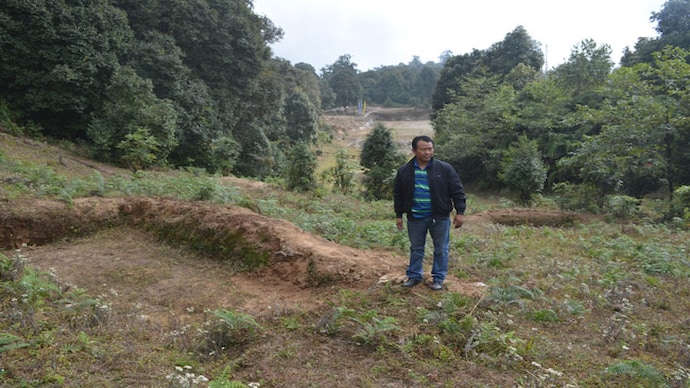Amid climate change, Sikkim adapts to falling MGNREGA funds
In this water-starved South Sikkim district, the new challenge is adapting to a changing Mahatma Gandhi National Rural Employment Guarantee Act - the flagship welfare scheme of the previous UPA government that the new NDA government isn't keen to shower funds on.


To adapt to climate change, villagers in this rain shadow region of Sikkim revived drying springs and lakes, converted sloping farmlands into terraces and planted trees from the 100 days' employment guarantee scheme. But even as the springs flow bountifully now, the funds that revived the aquifers are drying up.
And in this water-starved South Sikkim district, the new challenge is adapting to a changing Mahatma Gandhi National Rural Employment Guarantee Act - the flagship welfare scheme of the previous UPA government that the new NDA government isn't keen to shower funds on.
"MGNREGA funds have been slashed, by half, this year," Benu Gurung, a bureaucrat handling the scheme in this part of the tiny Himalayan state, told a group of reporters at a workshop on climate change here on November 19.
The result: reluctant adaptation.
With less money for wages, work under MGNREGA, is being "prioritised", said Gurung, the Additional Deputy Commissioner of Namchi.
"We are targeting the poorest first," she told IndiaToday.in.
The administration is also careful that the money is spent wisely. "We are more vigilant with the funds now since the funds are not much," she said.
Yet, the officer remains optimistic. "We have a five-year plan prepared (on the allocation of funds)."
The MNREGA debate
A fierce debate is already raging among economists, planners and activists over the Narendra Modi government's move to scale down MGNREGA's scope to just the poorest districts.
On December 2, thousands from across the country converged in New Delhi for a mega rally to demand safeguarding of their rights. One of the demands of the rally, akin to the climate change march in New York on September 22, was keeping the MGNREGA intact. Their contention: the scheme just costs 0.3 per cent of the country's gross domestic product.

However, Gurung's senior, Sandeep Tambe, commissioner inSikkim's Rural Management and Development Department, said they have managed to convince theUnion Rural Development Ministry, now led by Birendra Singh, to increase MGNREGA funding for this year.
"We have asked for more funds from the ministry and we have been assured that funds will be made available," he told IndiaToday.in on phone after a meeting with ministry officials in Delhi on December 17.
Asked how his department was prioritising on MGNREGA work in Sikkim, he said they were targeting private lands now, instead of government-owned lands, to create assets.
Moving on from creating durable assets such as reviving springs or terrace farms when the money was more than enough, the focus was now on creating income-generating assets, he said.
"We are focussing more on developing horticulture and animal husbandry," said Tambe, who is credited for making the apparently corruption-ridden scheme a success in the state.
Durable assets
One such MGNREGA success story is the mountain village of Perbing, some 50 km from Namchi town, which the reporters' group visited on Nov 18.
"We want 'Narega' to come back to the village," a elderly farmer and a panchayat member told this reporter as he climbed down the hill on an all-weather cemented footpath they built with the same Central funds.

Perbing is a "model" village on how to make "durable assets" with MGNREGA funds without any corruption.
The village is also a showpiece in this region on how to smartly use Central funds to resolve the water crisis -the fallout of the mountainous topology, rising temperatures and changing rain patterns attributed to climate change.
As one climbs to the hilltop, one sees hundreds of low trenches dug out at short distances. These rectangular dugouts 10 feet long and 2.5 feet deep hold rainwater during monsoon and let the water percolate and refill the aquifers in the rocks underneath, which in turn make the drying springs perennial once again.
The wages for digging these shallow trenches under MNREGA: Rs 155 per trench per person. It has been a massive project, titled 'Dhara Vikas'. There are said to be at least 20,000 such trenches in the Namthang block we visited.
Cutting corruption
One can see this board, displayed near the trenches, saying that Rs 1.88 lakh was sanctioned for Dhara Vikas but the villagers completed the work for Rs 1.26 lakh -saving over Rs 62,000, which is then returned.
There is no scope for any corruption, a panchayat member told IndiaToday.in, since all the spending is verified through a process called "social audit" at a village meeting.
"All the muster rolls are read out and villagers will be asked if cement or the stones were used. The gram sabhas vet our spending. For fake bills, the money is taken back from the functionary. So the functionaries become accountable to the people. They don't want to be humiliated," Tambe had said in an interaction with reporters on November 17.